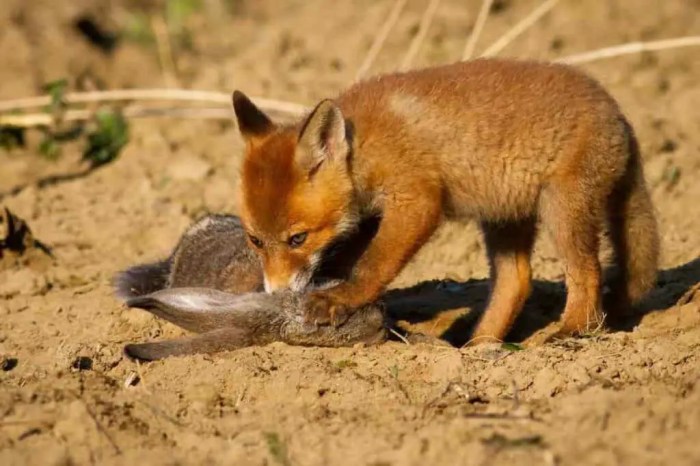The relationship between foxes and rabbits is a fascinating one, characterized by a delicate balance of predator and prey. Foxes are cunning and opportunistic carnivores, while rabbits are prolific and adaptable herbivores. In this article, we will delve into the intriguing question: Do foxes eat rabbits? We will explore the dietary habits of foxes, their hunting techniques, the impact of fox predation on rabbit populations, and the historical and geographical factors that shape their interactions.
Foxes are generalist predators with a diverse diet that includes small mammals, birds, insects, and fruits. Rabbits, with their abundance and nutritional value, play a significant role in the fox’s diet. Foxes have evolved specialized hunting techniques to capture rabbits, relying on their keen senses, stealth, and camouflage.
The impact of fox predation on rabbit populations is complex and varies depending on environmental factors, but studies have shown a correlation between fox presence and rabbit population decline.
Fox Diet
Foxes are opportunistic predators with a diverse diet that includes a wide range of small mammals, birds, insects, and even fruits and vegetables. Their nutritional requirements include protein, carbohydrates, fats, vitamins, and minerals, which they obtain from their prey.
Rabbits are a significant part of the fox’s diet, particularly in areas where rabbit populations are abundant. Foxes hunt rabbits by using their keen senses of smell and hearing to locate them. Once they have found a rabbit, they will typically chase it down and kill it with a bite to the neck.
Rabbit Species Commonly Consumed by Foxes
- Cottontail rabbits
- Jackrabbits
- Snowshoe hares
- European rabbits
Hunting Techniques
Foxes are adept hunters, employing various techniques to capture rabbits. Their keen senses and stealthy approach make them formidable predators.
Foxes rely heavily on their hearing and smell to locate rabbits. Their large ears can detect the slightest rustling or scratching sounds, while their sensitive noses can pick up on subtle scents. This allows them to pinpoint the location of their prey with remarkable accuracy.
Stealth and Camouflage
Stealth and camouflage play crucial roles in a fox’s hunting strategy. Foxes use their reddish-brown fur to blend in with their surroundings, making them less visible to rabbits. They also move with extreme caution, using cover and vegetation to avoid detection.
Impact on Rabbit Populations

Fox predation has a significant impact on rabbit populations. Studies have demonstrated a strong correlation between fox presence and rabbit population decline. For example, a study in Australia found that areas with high fox densities had 90% lower rabbit densities than areas with low fox densities.
Consequences for Rabbit Ecosystems
The decline in rabbit populations due to fox predation can have several consequences for rabbit ecosystems. Rabbits are an important food source for many predators, including eagles, hawks, and owls. The reduction in rabbit populations can lead to a decline in these predator populations.
Additionally, rabbits play a role in seed dispersal and nutrient cycling. Their decline can impact plant communities and soil health.
Geographical Distribution
Foxes and rabbits share overlapping geographical ranges in various regions worldwide. Their distribution is influenced by a combination of environmental factors, including habitat and climate.
Foxes are adaptable predators found in diverse habitats, including forests, grasslands, deserts, and even urban areas. Their ability to thrive in different environments contributes to their widespread distribution.
Rabbits, on the other hand, prefer open habitats with ample vegetation for cover and food. They are commonly found in grasslands, meadows, and agricultural areas.
Overlapping Ranges
The geographical ranges of foxes and rabbits overlap in several regions, including:
- North America: Foxes and rabbits are found throughout North America, from the northern tundra to the southern deserts.
- Europe: Foxes and rabbits are common in Europe, with a high concentration in the British Isles and Central Europe.
- Asia: Foxes and rabbits are found in many parts of Asia, including China, Japan, and the Middle East.
- Australia: Both foxes and rabbits were introduced to Australia by humans and have established populations in many parts of the country.
Historical Interactions
Foxes and rabbits have coexisted for millions of years, sharing an evolutionary relationship as predators and prey. The predator-prey dynamics between these species have been shaped by changes in land use and human activities.
Cultural and Folklore References
The relationship between foxes and rabbits has been depicted in various cultural and folklore references, often portraying the fox as a cunning predator and the rabbit as a clever evader. Examples include Aesop’s fable “The Fox and the Grapes” and the English nursery rhyme “Peter Rabbit.”
These stories reflect the historical interactions between these species and their perceived characteristics.
Final Summary
The relationship between foxes and rabbits is a dynamic and ever-evolving one, influenced by a multitude of factors. Foxes are essential predators in ecosystems, helping to control rabbit populations and maintain ecological balance. Understanding the intricacies of this predator-prey relationship is crucial for wildlife management and conservation efforts.
As we continue to explore the fascinating world of nature, we gain a deeper appreciation for the interconnectedness of species and the delicate balance that sustains our ecosystems.
Helpful Answers
Do all foxes eat rabbits?
Yes, rabbits are a common food source for most fox species worldwide.
What are the main hunting techniques used by foxes to catch rabbits?
Foxes use various techniques, including stalking, ambushing, and pouncing, to capture rabbits.
How does fox predation affect rabbit populations?
Fox predation can significantly reduce rabbit populations, especially in areas where foxes are abundant.
What factors influence the geographical distribution of foxes and rabbits?
Habitat availability, climate, and human activities are key factors that influence the distribution of both species.